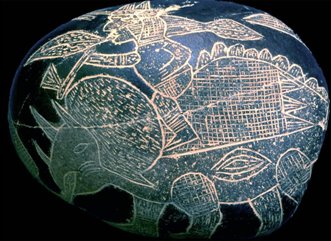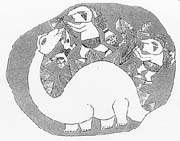You should try posting all this on an actual science forum and see what they say.
Looks like you already tried it here and it didn't work out very well.
Science Disproves Evolution - SciForums.com
Here are the facts
- The word theory, in the context of science, does not imply uncertainty. It means "a coherent group of general propositions used as principles of explanation for a class of phenomena" (Barnhart 1948). In the case of the theory of evolution, the following are some of the phenomena involved. All are facts:Many other facts are explained by the theory of evolution as well.
- Life appeared on earth more than two billion years ago;
- Life forms have changed and diversified over life's history;
- Species are related via common descent from one or a few common ancestors;
- Natural selection is a significant factor affecting how species change.
- The theory of evolution has proved itself in practice. It has useful applications in epidemiology, pest control, drug discovery, and other areas (Bull and Wichman 2001; Eisen and Wu 2002; Searls 2003).
- Besides the theory, there is the fact of evolution, the observation that life has changed greatly over time. The fact of evolution was recognized even before Darwin's theory. The theory of evolution explains the fact.
- If "only a theory" were a real objection, creationists would also be issuing disclaimers complaining about the theory of gravity, atomic theory, the germ theory of disease, and the theory of limits (on which calculus is based). The theory of evolution is no less valid than any of these. Even the theory of gravity still receives serious challenges (Milgrom 2002). Yet the phenomenon of gravity, like evolution, is still a fact.
- Creationism is neither theory nor fact; it is, at best, only an opinion. Since it explains nothing, it is scientifically useless.
An Index to Creationist Claims
Science Disproves Evolution:
Evolution: The Anti-science
Some evolutionists have argued that
science isn’t possible without evolution. They teach that science and technology actually require the principles of molecules-to-man evolution in order to work. They claim that those who hold to a biblical creation worldview are in danger of not being able to understand science!
1[SUP],[/SUP]
2[SUP],[/SUP]
3
Critical thinkers will realize that these kinds of arguments are quite ironic because evolution is actually
contrary to the principles of science. That is, if evolution were true, the concept of science would not make sense. Science actually requires a biblical creation framework in order to be possible. Here’s why:
The Preconditions of Science
Science presupposes that the universe is logical and orderly and that it obeys mathematical laws that are consistent over time and space. Even though conditions in different regions of space and eras of time are quite diverse, there is nonetheless an underlying uniformity.
4
Because there is such regularity in the universe, there are many instances where scientists are able to make successful predictions about the future. For example, astronomers can successfully compute the positions of the planets, moons, and asteroids far into the future. Without uniformity in nature, such predictions would be impossible, and science could not exist. The problem for evolutionism is that such regularity only makes sense in a biblical creation worldview.
Science Requires a Biblical Worldview
The biblical creationist expects there to be order in the universe because God made all things (
John 1:3) and has imposed order on the universe. Since the Bible teaches that God upholds all things by His power (
Hebrews 1:3), the creationist expects that the universe would function in a logical, orderly, law-like fashion.
5 Furthermore, God is consistent
6 and omnipresent.
7 Thus, the creationist expects that all regions of the universe will obey the same laws, even in regions where the physical conditions are quite different. The entire field of
astronomy requires this important biblical principle.
Moreover, God is beyond time (
2 Peter 3:8) and has chosen to uphold the universe in a consistent fashion throughout time for our benefit. So, even though conditions in the past may be quite different than those in the present and future, the way God upholds the universe (what we would call the “laws of nature”) will not arbitrarily change.
8 God has told us that there are certain things we can count on to be true in the future—the seasons, the diurnal cycle, and so on (
Genesis 8:22). Therefore, under a given set of conditions, the consistent Christian has the right to expect a given outcome because he or she relies upon the Lord to uphold the universe in a consistent way.
These Christian principles are absolutely essential to science. When we perform a controlled experiment using the same preset starting conditions, we expect to get the same result every time. The “future reflects the past” in this sense. Scientists are able to make predictions only because there is uniformity as a result of God’s sovereign and consistent power. Scientific experimentation would be pointless without uniformity; we would get a different result every time we performed an identical experiment, destroying the very possibility of scientific knowledge.
Can an Evolutionist Do Science?
Since science requires the biblical principle of uniformity (as well as a number of other biblical creation principles), it is rather amazing that one could be a scientist and also an evolutionist. And yet, there are scientists that profess to believe in evolution. How is this possible?
The answer is that evolutionists are able to do science only because they are inconsistent. They accept biblical principles such as uniformity, while simultaneously denying the Bible from which those principles are derived. Such inconsistency is common in secular thinking; secular scientists claim that the universe is not designed, but they do science as if the universe
is designed and upheld by God in a uniform way. Evolutionists can do science only if they rely on biblical creation assumptions (such as uniformity) that are contrary to their professed belief in evolution.
9
How Would an Evolutionist Respond?
The consistent Christian can use past experience as a guide for what is likely to happen in the future because God has promised us that (in certain ways) the future will reflect the past (
Genesis 8:22). But how can those who reject Genesis explain why there should be uniformity of nature? How might an evolutionist respond if asked, “Why will the future reflect the past?”
One of the most common responses is: “Well, it always has. So, I expect it always will.” But this is circular reasoning. I’ll grant that in the past there has been uniformity.
10 But how do I know that in the future there will be uniformity—unless I already assumed that the future reflects the past (i.e. uniformity)? Whenever we use past experience as a basis for what is likely to happen in the future, we are assuming uniformity. So, when an evolutionist says that he believes there will be uniformity in the future since there has been uniformity in the past, he’s trying to justify uniformity by simply assuming uniformity—a circular argument.
An evolutionist might argue that the nature of matter is such that it behaves in a regular fashion;
11 in other words, uniformity is just a property of the universe. This answer also fails. First, it doesn’t really answer the question. Perhaps uniformity is one aspect of the universe, but the question is why? What would be the basis for such a property in an evolutionary worldview? Second, we might ask how an evolutionist could possibly know that uniformity is a property of the universe. At best, he or she can only say that the universe—in the past—seems to have had some uniformity.
12 But how do we know that will continue into the future unless we already knew about uniformity some other way? Many things in this universe change; how do we know that the laws of nature will not?
Some evolutionists might try a more pragmatic response: “Well, I can’t really explain why. But uniformity seems to work, so we use it.” This answer also fails for two reasons. First, we can only argue that uniformity seems to have worked in the
past; there’s no guarantee it will continue to work in the future unless you already have a reason to assume uniformity (which only the Christian does). Yet, evolutionists do assume that uniformity will be true in the future. Second, the answer admits that uniformity is without justification in the evolutionary worldview—which is exactly the point. No one is denying that there is uniformity in nature; the point is that only a biblical creation worldview can make sense of it. Evolutionists can only do science if they are inconsistent: that is, if they assume biblical creationist concepts while denying biblical creation.
Theistic Evolution Won’t Save the Day
Some evolutionists might argue that they can account for uniformity just as the Christian does—by appealing to a god who upholds the universe in a law-like fashion.
13 But rather than believing in Genesis creation, they believe that this god created over millions of years of evolution. However, theistic evolution will not resolve the problem. A theistic evolutionist does not believe that Genesis is literally true. But if Genesis is not literally true, then there is no reason to believe that
Genesis 8:22 is literally true. This verse is where God promises that we can count on a certain degree of uniformity in the future. Without biblical creation, the rational basis for uniformity is lost.
It’s not just any god that is required in order to make sense of uniformity; it is the Christian God as revealed in the Bible. Only a God who is beyond time, consistent, faithful, all powerful, omnipresent, and who has revealed Himself to mankind can guarantee that there will be uniformity throughout space and time. Therefore, only biblical creationists can account for the uniformity in nature.
Evolution Is Irrational
In fact, if evolution were true, there wouldn’t be any rational reason to believe it! If life is the result of evolution, then it means that an evolutionist’s brain is simply the outworking of millions of years of random-chance processes. The brain would simply be a collection of chemical reactions that have been preserved because they had some sort of survival value in the past. If evolution were true, then all the evolutionist’s thoughts are merely the necessary result of chemistry acting over time. Therefore, an evolutionist must think and say that “evolution is true” not for rational reasons, but as a necessary consequence of blind chemistry.
Scholarly analysis presupposes that the human mind is
not just chemistry. Rationality presupposes that we have the freedom to consciously consider the various options and choose the best. Evolutionism undermines the preconditions necessary for rational thought, thereby destroying the very possibility of knowledge and science.
Conclusions
Evolution is anti-science and anti-knowledge. If evolution were true, science would not be possible because there would be no reason to accept the uniformity of nature upon which all science and technology depend. Nor would there be any reason to think that rational analysis would be possible since the thoughts of our mind would be nothing more than the inevitable result of mindless chemical reactions. Evolutionists are able to do science and gain knowledge only because they are inconsistent; professing to believe in evolution, while accepting the principles of biblical creation.
Footnotes
Theodosius Dobzhansky wrote, “Nothing in biology makes sense except in the light of evolution.” This was also the title of his 1973 essay first published in the American Biology Teacher, Vol. 35, p. 125–129. Back
The National Academy of Sciences issued a book called Science, Evolution, and Creationism which stated that evolution is a “critical foundation of the biomedical and life sciences . . .” and that evolutionary concepts “are fundamental to a high-quality science education.” (See The Creation/Evolution Battle Resumes.) Back
The National Academy of Sciences also published a document called “Teaching About Evolution and the Nature of Science” (1998) with a similar theme. In the preface (p. viii) the authors indicate that biological evolution is “the most important concept in modern biology, a concept essential to understanding key aspects of living things.” They chose to publish the document in part “because of the importance of evolution as a central concept in understanding our planet.” Back
Uniformity should not be confused with “uniformitarianism.” Uniformity simply insists that the laws of nature are consistent and do not arbitrarily change with time or space, though specific conditions and processes may change. Uniformitarianism is the (unbiblical) belief that present processes are the same as past processes; it asserts a consistency of conditions and rates over time and is summed up in the phrase, “The present is the key to the past.” Back
The “ordinances of heaven and earth” are specifically mentioned in Jeremiah 33:25. Back
1 Samuel 15:29; Numbers 23:19 Back
Psalm 139:7–8 Back
Granted, God can use unusual and extraordinary means on occasion to accomplish an extraordinary purpose—what we might call a “miracle.” But these are (by definition) exceptional; natural law could be defined as the ordinary way that God upholds the universe and accomplishes His will. Back
Why would someone who professes to believe in evolution also accept creation-based concepts? Although they may deny it, evolutionists are also made in the image of God (Genesis 1:26–27). In their heart-of-hearts, they know the biblical God (Romans 1:19–20), but they have deceived themselves (James 1:22–24). They have forgotten that the principles of science come from the Christian worldview. Back
In granting this assumption, I’m actually being very generous to the evolutionist. I could have been very thorough and asked, “How do we really know that even in the past nature has been uniform?” One might argue that we remember that the past was uniform. But since the memory portions of our brain require that the laws of chemistry and physics are constant over time, you would have to assume that the past is uniform in order to argue that we correctly remember that the past is uniform! Any non-Christian response would be necessarily circular. Back
The atheist Dr. Gordon Stein used essentially this response in the famous 1985 debate with Christian philosopher Dr. Greg Bahnsen on the existence of God. Back
Again, I’m being generous here. Even this response is begging the question, since the evolutionist would have to assume uniformity in the past in order to argue that his memories of the past are accurate. Back
A “day-age” creationist might also try to use this argument. But it also fails for the same reason. Day-age creationists do not believe that Genesis really means what it says (that God literally created in six ordinary days). So, how could we trust that Genesis 8:22 really means what it says? And if Genesis 8:22 does not mean what it says, then there is no reason to believe in uniformity. Therefore, the day-age creationist has the same problem as the evolutionist. Neither can account for science and technology within his own worldview. Back
Evolution: The Anti-science - Answers in Genesis










